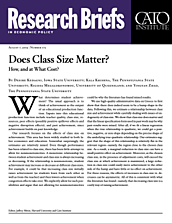Our research focuses on the effects of class size on achievement. This area has been widely studied in both labor economics and education. Somewhat surprisingly, the estimates are relatively mixed. Even though performance has been related to class size, there has been little attempt to allow for nonmonotonicities. A monotonic relationship between student achievement and class size is always increasing or decreasing. If the relationship is nonmonotonic, student achievement may increase or decrease at different class sizes. For example, it could be that increasing class size initially raises achievement (as students learn from each other as well as from the teacher) and then lowers achievement when congestion effects take over. We explicitly allow for such possibilities and argue that not allowing for nonmonotonicities could be why the literature has found mixed results.
We use high-quality administrative data on Greece to first show that there does indeed seem to be a hump shape in the data. Following this, we estimate a relationship between class size and achievement while carefully dealing with issues of endogeneity of class size. We show that class size does matter and that the linear specification form used in past work may be why past results were mixed. After all, if we fit a linear regression when the true relationship is quadratic, we could get a positive, negative, or zero slope depending on the precise shape of the underlying true quadratic relationship. Our estimates suggest that the shape of this relationship is relatively flat in the relevant region—namely, the region close to the chosen class size. As a result, a marginal reduction in class size can have a small positive effect on achievement. Moreover, as the chosen class size, in the presence of adjustment costs, will exceed the class size at which achievement is maximized, a large reduction in class size could easily move achievement to the other side of the hump and have little or no effect on achievement. For these reasons, the effects of increases in class size vs. decreases can be asymmetric. All of this is consistent with what the literature has found — namely, that decreasing class size is a costly way of raising achievement.
We further explore the data to look for evidence of quantile effects. We find that the hump shape is present across all quantiles — that is, for students of all abilities. The hump shape is, however, more pronounced for worse students.
With the estimates of the effects of class size on achievement in hand, we are in a position to understand how class size is chosen. If the government cares about achievement andaddresses the costs of adding classes, its behavior — in relation to the number of classes it chooses as enrollment fluctuates — helps us estimate the costs involved. We use our estimates to assess hiring and firing and the marginal cost of adding a class. Our estimates here are in line with actual teacher salaries. Finally, in Greece, as in much of the rest of the world, teachers unions are a powerful force to be reckoned with. Their power is demonstrated not only by the wages they set but by their ability to fire teachers at will. We use our model to determine whether inflexibility, expressed in terms of unions creating high firing (and even hiring) costs, might be driving government class-size choices and the impact of this on student achievement. We find that unions, even if they raise costs and class size, have a small effect on achievement.
NOTE:
This research brief is based on Desire Kedagni, Kala Krishna, Rigissa Megalokonomou, and Yingyan Zhao, “Does Class Size Matter? How, and at What Cost?,” NBER Working Paper no. 25736, April 2019, http://www.nber.org/papers/w25736.

